
Articles suggérés
Sur des sujets similaires
La pandémie de COVID-19 et les défis qu'elle comporte ont possiblement créé une occasion unique dans le secteur de la communication liée aux soins de santé.
SHIFT Communications, la compagnie sœur de NATIONAL aux États-Unis, a interrogé des experts en relations publiques et en communications dans le domaine des soins de santé pour connaître leurs réalisations et leurs priorités. Leurs réponses, présentées ci-dessous, constituent un excellent baromètre pour la planification de 2022.
(L'article est en anglais.)
———
The pandemic and its ongoing challenges created what is perhaps a once-in-a-generation opportunity for healthcare storytelling.
People from all walks of life are interested in learning about science; they’re prioritizing their health and looking for ways to improve their overall wellbeing. With hundreds of businesses across the healthcare spectrum offering new solutions for everything from massive public health challenges to very personal health and wellness issues, however, it’s harder than ever for any one company to stand out.
Healthcare communicators must seize this moment to clearly define and communicate their company’s brand, why they do what they do and why others should care—now.
SHIFT Communications, NATIONAL's sister company in the U.S., has polled some key Healthcare Public Relations and Communications experts to find out what's been working and what they're prioritizing. Their answers below are a strong barometer for 2022 planning.
Companies investing in growth
Most of the companies SHIFT spoke with saw 2021 and 2022, despite inherent challenges, as a time to invest in growth opportunities. Several mega forces are at play creating these opportunities: the global spotlight on the healthcare sector; accelerated adoption of technology; and an increase in firsthand dealings of healthcare issues (pandemic and non-pandemic) in each of our lives.

Competition multiplying
New companies with future-forward business models are being founded. Many in the digital health space are merging to create powerhouse businesses, while others are bullishly investing more resources into boosting their reputation.
This leaves both existing and new businesses vying for the attention of would-be investors, customers, acquirers and mindshare.
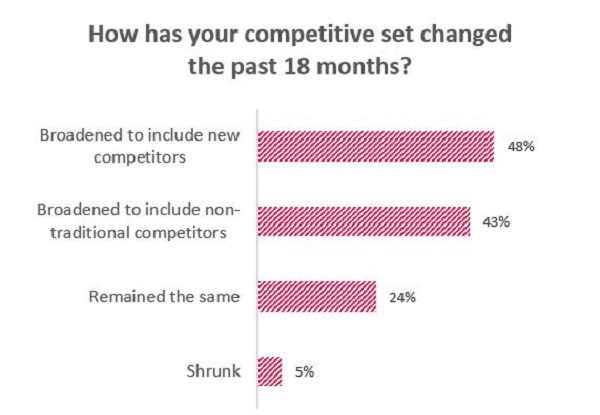
This is a critical moment in healthcare communications—for companies in every corner of the space, from pharmaceutical to life sciences, digital health, medical device manufacturers and beyond. It’s never been more important to think beyond Public Relations’ traditional confines and swim lanes.
That’s why we created this survey and report; to share trending priorities and opportunities, as identified by over 20 healthcare Communications, Marketing and Public Relations professionals.
The findings are a strong barometer and source for 2022 planning. Because if the company you represent isn’t leading in these areas, it’s falling behind.
The biggest takeaways from our virtual roundtable survey are as follows:
1. Narratives must be revisited and revised
Revisiting market fit
The way we live, work and access healthcare has been forever disrupted. As such, companies and communications professionals are tasked with finding new ways to make their brands shine.
Businesses must revisit market fit across all areas—product or service offering, customer experience and communications—or risk falling out of step with the competition.
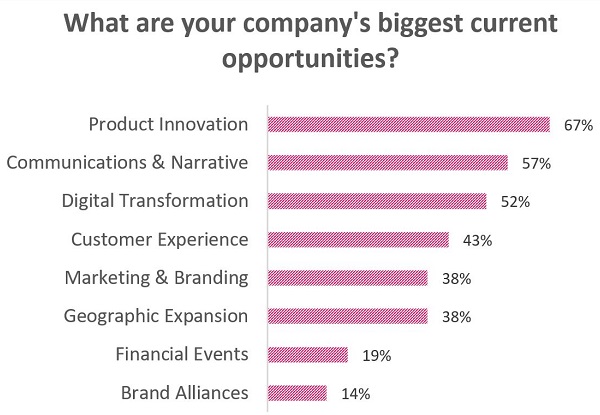
Updating the business narrative
Given how strategically important the brand narrative is as a business framework, brand story must be seen as an ongoing, iterative process rather than a finished product.
If you haven’t recently reviewed narrative, you’re likely out of sync with current market needs and trends. At minimum, we recommend checking in annually to make sure that brand messaging and story still correctly position the business—and that the story and proof points reflect what is happening in the customer and client landscape.
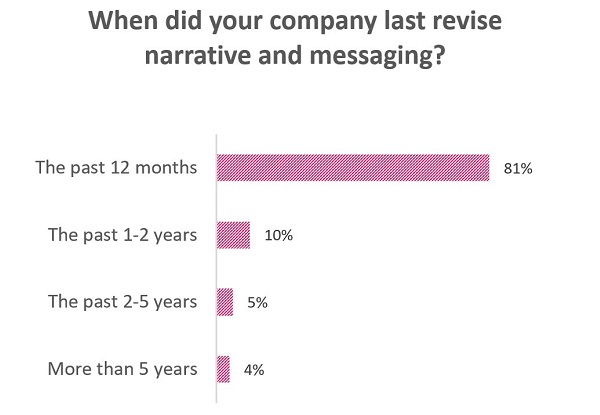
2. Storylines must be expanded
Becoming a source of timely trends
The healthcare market has become an increasingly complex and sophisticated ecosystem to operate in.
Market and customer insights have supplanted technical product communications as the primary way to increase visibility for your brand and people. It’s what will make your audience appreciate the nuances of what you have built and how you can help them.
Topic expansion is critical to a successful Public Relations program. We recommend quarterly topic analysis and competitive audits to understand how a company might be able to join larger public moments and industry conversations as well as to uncover white spaces to build around.
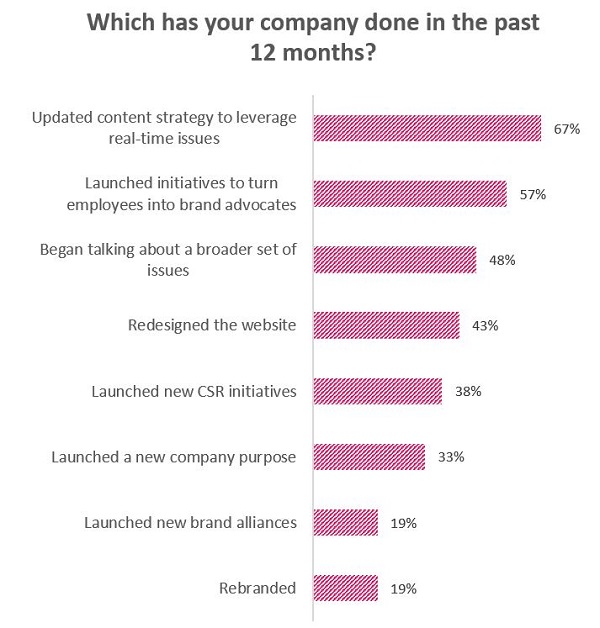
3. Public Relations must extend beyond earned media
Making better use of digital channels
Earned media remains an important validator—one of the most important, trusted by twice as many people as paid advertising.
However, the symmetry between opportunity and competition necessitates an elevation of healthcare Public Relations. It calls for exploration of new ways to propel a company.
This means Public Relations can’t be looked at through narrow lanes of earned media and social media. Rather, it must be looked at as “idea generation” that can connect companies and their stakeholders—and make better use of the array of digital channels at our disposal.
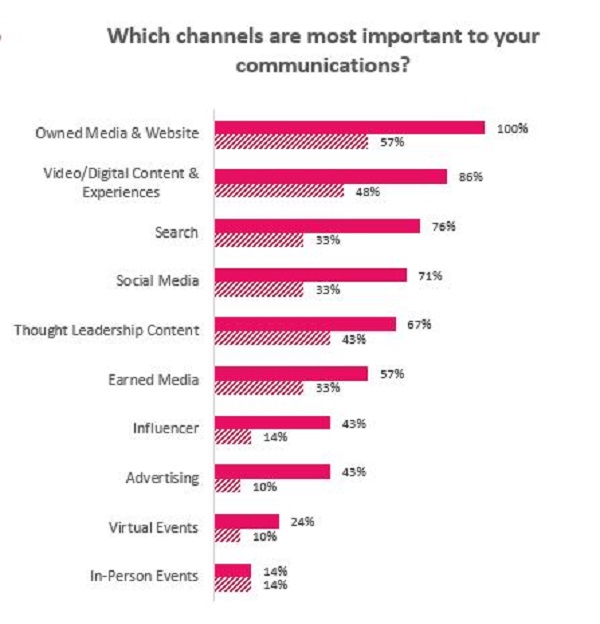

Zeroing in on social and digital
Although “Public Relations” budgets also grew over the past 18 months, Social Media Marketing and Digital Experiences saw the largest increase in spend.
Once reserved for B2C companies and only the boldest of B2B, social media has become increasingly important to all corners of healthcare. We recommend thinking beyond LinkedIn and Twitter as, surprisingly, channels from TikTok to Clubhouse may have a captive and relevant audience who is willing to connect.
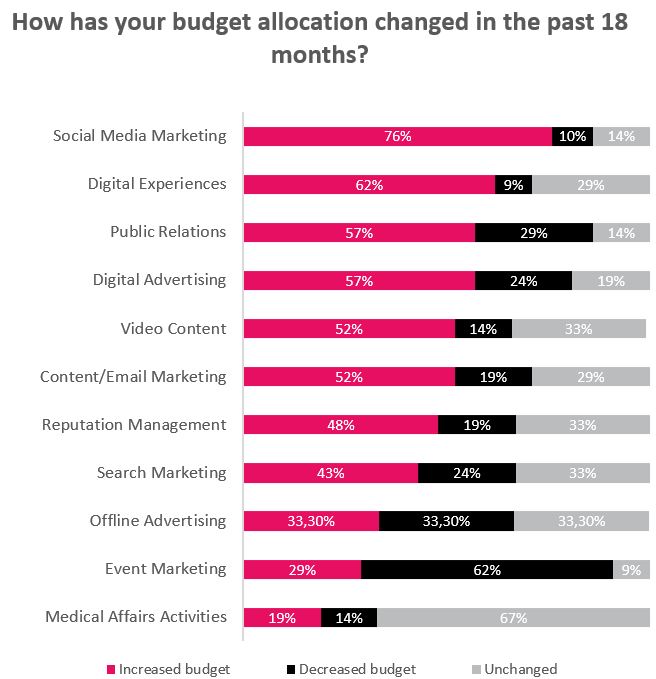
What worked in 2021
Perhaps more notably, when asked what recent campaigns and communications efforts worked best for them, a few respondents’ answers demonstrated the importance of looking at Public Relations more progressively.
This is key—from the channels to the type of language to the boldness of idea we use—to carving out differentiation and attention moving forward.
A progressive approach to 2022
Breaking outside Public Relations confines
As we’ve seen in our own work at SHIFT and in the findings from our survey, we are embracing a new way of working.
When asked about the biggest opportunities they saw for their brand story and bringing it to life into 2022, a few respondents noted areas that went beyond conventional healthcare Public Relations.
Now is the time to refresh our brands to talk about how we’re solving the healthcare challenges of today and tomorrow and to explore to new models for engaging and building relationships with (not just selling to) our stakeholders.
Going big
Amid a time of societal and industry turmoil, it’s never been harder for healthcare communicators to build brand awareness and drive engagement.
2022 is a time to recognize the past limitations of our discipline and think about Public Relations more broadly. This can admittedly be challenging in a sector historically ruled by confidentiality, conservative campaigns and technical terminology. But it’s critical, whether for a pharmaceutical giant raising awareness for drug trials or a B2B software provider for whom communications is evolving to look more like B2C every day.
2022 is a time for big ideas—not just more earned media; ones rooted in digital and delivered meaningfully, from business to human.
Click here to read and download the report on SHIFT's website

